
It has been such a cold and miserable winter for me. In more ways than one… As a brand new gardener, I cannot WAIT for spring! Today I finally saw my first-ever baby daffodils emerging from my garden! It feels like a miracle! I am so excited!

It has been such a cold and miserable winter for me. In more ways than one… As a brand new gardener, I cannot WAIT for spring! Today I finally saw my first-ever baby daffodils emerging from my garden! It feels like a miracle! I am so excited!

Saturday, December 9, we got about 1-2 inches of snow. It was beautiful and didn’t stick to the roads. So the BEST kind of snow!
I took these photos Sunday morning.

Maiden Grass


Butterfly Bush


(Left to Right) Butterfly Weed, Elderberry shrub and Beautyberry shrub

The bird bath looks like a big margarita!

Agastache and Calico Aster

Nope… not sitting down today!


Sweet Shrub behind the lantern

Clematis
Hopefully we won’t get any blizzards this year. But I love snow storms like this!
After I finished planting I sat down in the garden to rest, and right away there were three hairy woodpeckers, a red-bellied woodpecker, and several sparrows enjoying birdseed and suet in my front yard. I love watching the birds!
I am planning on installing a water feature in the spring that will draw even more birds and wildlife to my yard. I saw a segment about it on a local gardening TV show, “Virginia Home Grown”. It’s called The Bird Spa. You put it together yourself with items you can buy yourself. It provides clean running water and a dripper. It lasts for years. You can buy an instruction manual for $15 on the website:
http://www.iphotobirds.com/TheBirdSpa/

This weekend I planted my Rosemary, which has been in a pot since spring. From what I’ve read, it may not make it through the winter here. But I’m going to try anyway. I planted it in front of the house, and mulched it very well. Despite many nights with hard frosts so far, it still looks good.
I love that it’s evergreen. It smells so nice! Many times this summer I ran my hands across the needles and inhaled the wonderful scent.
I have used it in a few recipes. I read online that it’s delicious mixed with olive oil and a little salt, then you can dip fresh, warm bread into the oil. Yum!
Rosemary can grow as large as a shrub: 3 feet high by 5 feet wide in the right conditions. It can even be trained as a topiary.
Rosemary is native along the coast of the Mediterranean, so it means “dew of the sea” because it grows so well in those areas.


I planted 3 Allium Globemaster bulbs at the front of the garden. They look like something from a Dr. Suess book. They have 8″-10″ wide purple globes made of tiny flowers on top of 2′-3′ stalks. Bees love them! They are members of the onion family. The bulbs look a lot like onions. After blooming they become beautiful seedpod orbs. They are resistant to damage from rabbits, rodents and deer. ‘G
But they will colonize over time.
I can’t wait to see the leaves form a clump of foliage in spring. Then as the leaves begin to wither in mid-spring, stout flowering stems will rise topped with the huge, globular flower heads.

I also planted two Tequila Sunrise Mix Hyacinth bulbs that my friend, Gail, gave me. She bought them to force bulbs indoors over the winter. She gave me the extras. It will be a surprise to find out which colors they pop up as in spring.
Tequila Sunrise is an innovative combo of colors that are both ‘hot’ and ‘cool’: buttery yellow, deep orange, and deep purple.
My Maiden Grass’ soft, beautiful seed heads look so pretty blowing in the breeze.
I recently learned that it is considered an invasive species because it spreads like crazy if you have more than one in an area. So I won’t be buying a second one.
In the future I am only going to buy native grasses, which I love.

The squirrels have been munching on the dried corn I hang for them in a tree.

And the birds, especially the woodpeckers, love suet. I hung these feeders up on a hook where a plant and hummingbird feeder were hanging earlier in the year.
I was very excited to get my first ever order of bulbs in the mail from John Scheepers a few weeks ago. The bulbs are big and beautiful: Daffodils and Hyacinths.


It took a couple of weekends to create a bulb bed for them but I finally got them planted this weekend.


I dug a grave (pretty much) at the front of my garden, 5 feet long, 3 feet wide, and a foot deep! Using my trusty 5-gallon buckets, I threw all that nasty, thick clay into the woods. Then I filled the grave halfway with compost and top soil, placed the bulbs in, and covered them with top soil.
I cannot wait until April!
The following info about my bulbs comes from http://www.johnscheepers.com:
Jonquilla Narcissi
All sweetly fragrant, Jonquilla Narcissi yield one to five, and occasionally more, flowers per stem. Its foliage is rather slender. Jonquils are ideal for naturalizing as well as for forcing. They are also much loved for the fact that deer and rodents do not like to eat them!
Tazetta Narcissi
A vigorous, multi-flowering strain with several stems per bulb, fragrant Tazetta Narcissi create lush, full displays with two to twenty flowers with spreading petals per stout stem.

Lemon Sailboat (Jonquilla) (10 bulbs)
New! This Sailboat sport has 2 1/2″, reflexed lemon-yellow flowers with funnel-shaped cups. Blooms in May. 10″ to 12″ tall.

Falconet (Tarzetta) (10 bulbs)
Fragrant Falconet is a Grant Mitsch variety has up to eight, perfectly formed, yellow florets per stem with orange crowns. Good for warmer climates, it is also a terrific forcer. Blooms in April. 12″ to 14″ tall.

Sweet Love (Jonquilla) (10 bulbs)
Deliciously fragrant Sweet Love has perfectly formed ivory-white flowers with wavy, ivory-edged, butter-yellow cups that mature to ivory with yellow throats. Blooms in May. 14″ to 16″ tall.

Avalanche (Tarzetta) (10 bulbs)
Sweetly fragrant Avalanche is also known as the Seventeen Sisters for its multitudinous cascade of dollish 1″ flowers. A naturalizing 1906 heirloom, it has a creamy-white perianth and a bowl-shaped, greenish-yellow cup. Ideal for warmer climates, it is also a good forcer. Blooms in April. 16″ to 18″ tall.
Hyacinth Orientalis
The sweet perfume and colorful rainbow of H. orientalis has filled the finest of gardens since the Dutch hybridized more plump, densely compacted flowering spikes than the original species found in the wild in the area of eastern Mediterranean back in the mid-sixteenth century. Our 16/17 cm size bulbs produce large, rigid and uniform flower spikes studded with slightly reflexed, tubular florets, also known as nails, and three to four, upright strappy leaves. They do not usually require staking. They are perfect for carefully plotted geometric garden designs as well as more casually incorporated clusters and drifts in mixed beds. After the first flowering season, the hefty flowering spikes become increasingly less compact for a more carefree English cottage garden look. You may want to plant new bulbs every two years since they tend to peter out naturally over time. Deer- and rodent-resistant, Hyacinth bulbs dislike getting wet feet: plant them in a very well-draining spot. Hyacinths are very good for forcing indoors over the winter.

Hyacinth Delft Blue (5 bulbs)
One of the most popular Hyacinths of all times, award-winning H. orientalis Delft Blue, circa 1944, has soft lilac-blue florets with paler edges. Delft Blue is the very best blue Hyacinth for early forcing. Height: 8″ to 12″. Blooms in April.

Hyacinth Fondant (5 bulbs)
Also called Pink Frosting, Fondant has neyron-rose florets with paler phlox-pink highlights. Hybridized in 1983, it has amassed numerous horticultural awards. Height: 8″ to 12″. Blooms in April.
I also bought 3 Globemaster Allium bulbs from John Scheepers. Hopefully I will get them planted next weekend.
This weekend the hard freeze killed all the non-hardies, but I was so excited to find these tiny yellow blooms on my Witch Hazel shrub that I planted last month!

Aren’t they cute? It amazes me every time I see a plant (that I planted) doing what it’s supposed to do! LOL!

Witch Hazel (aka Hamamelis virginiana) is a Virginia native shrub. It will grow to be 10-30 feet tall. Witch Hazel blooms when nothing else does (October through December)! The blooms are yellow and look like strings. They are very fragrant and smell like lemon zest.
The gray fruit take a long time to mature, and when they are disturbed they explode and send the seeds flying yards away.
Native Americans taught Europeans how to use the branches, bark and leaves medicinally as a skin astringent and to help with sores and insect bites.
Early settlers aka “water witching diviners” used forked branches of Witch Hazel (growing in north-south directions) as divining rods to find underground springs. They held onto the forked ends and walked around waiting for the other end to make a downward tugging movement, indicating water was underground.
The name may come from the phrase “wicke hazel” which meant “bending hazel”.
The last two weekends have been gray, wet, dreary, and chilly. Fall has always been my favorite season. But now that I’ve become a gardener, it feels sad.
We turned the clocks back last night. It will be dark much earlier in the evening, but at least it won’t be dark in the mornings anymore.
I started preparing my garden for winter today. I added mulch to the Coneflowers (Purple, Sombrero and Butterfly Julia), Brunerra Jack Frost, Endless Summer Hydrangea, Jet Stream Oak Leaf Hydrangea, Dwarf Japanese Maple, and the Kousa Japanese Dogwood tree.
I sure do LOVE the smell of mulch!
I trimmed the Irises to 6″ tall and covered them with straw.
I pulled out the Pink Beauty Calladium, white Impatiens, and one of the Russian Mammoth Sunflowers (that the birds cleaned of seeds), and added them all to the compost pile.
I had planned on keeping the Caladium bulb in the closet and replanting it in the spring. But I decided to replace it with a native plant instead. I’m not sure what to plant there. Any suggestions for a Virginia native plant that likes shade and provides food for birds?
Ever since I learned how invasive and poisonous Lily of the Valley is, it has been bugging me. So I yanked them out today. I will replace them with a native plant as well.
I still have some annuals blooming, so I will wait until the frost gets them before adding them to the compost.
David and I went to the dump yesterday. He noticed that the truck in front of us had some plants in the back. So we pulled up next to them and I asked the driver if I could have the plants. He asked, “You mean these old rotten ferns?” Yep! So I brought them home. Turns out they are two Boston Ferns. They are only hardy in Florida. So I brought them inside, gave them a good shower in the bathtub, spent about 30 minutes cutting out lots of dead stems, and put them on the refrigerator. I read that they need indirect bright light and humidity. So I placed the pots on dishes filled with pebbles and water, as the internet suggested. The kitchen has more light than any other room, so we shall see if I can keep them alive.
Here are some photos I took in the garden this weekend…

Seed heads on Calico Aster

I’m also leaving seed heads from Black Eyed Susans up for the birds

The birds found these sunflower seeds…

But not these… yet

Beautiful fall color on the Little Henry Itea

Spicebush also has really nice fall color

The Sombrero Coneflower is still blooming and it is gorgeous!

So is the Endless Summer Hydrangea!

Saturday I finally finished planting the native plants in my full-sun pollinator garden.
In September bought a lot of natives at Hummingbird Hill Native Plant Nursery in Crozet, Virginia, with help from a grant I received from the Alliance for The Chesapeake Bay (http://www.allianceforthebay.org/).

Hairy Beardtongue is a native wildflower with a very weird name (because of a tuft of yellow hairs that come out from the flower’s throat). Pale purple blooms look similar to foxglove or snapdragons, and they bloom late May to July. Bumblebees love to crawl up inside the flowers to get nectar, and to cover themselves in pollen.

Meadow Phlox is another native wildflower. It has pink-purple blooms with a sweet fragrance, great for cuttings. They bloom in summer and attract butterflies, bees, and hummingbirds. It is a host plant for some moths as well.

Lanceleaf Coreopsis is also a native wildflower with yellow, daisy-like flowers that bloom from spring to fall. They are also called tickseed, because the seeds look like ticks. I planted Threadleaf Coreopsis (also native) in the part-sun section of my garden. I plan to leave the seed heads on all of them over winter for birds, especially goldfinches, who love the seeds.

I planted two Turk’s Cap Lily bulbs. They will grow 6 feet or taller, and can have up to 40 blooms on each stalk in summer. The blooms are orange and look very similar to Tiger Lilies, but Turk’s Cap Lilies are native. They are very fragrant. They almost became extinct a few decades ago, because many people ate the bulbs, adding them to stews and meat recipes. But they are making a comeback.

Calico Aster is 3 to 4 feet tall and completely covered in tiny daisy-like flowers late-summer to mid-fall. Many butterflies and bees are attracted to it as a nectar source, and it is also a butterfly host plant. Small bees and flies are especially attracted to the little blooms.

Joe Pye Weed is named after a Native American medicine man who made concoctions from the plant to cure typhoid fever and stop an epidemic in Colonial Massachusetts. It grows 6′-8′ tall with “clouds” of mauve flowers with a sweet vanilla scent which attract hummingbirds, bees and butterflies. They bloom mid-summer to early-fall.

I also planted some seeds I ordered from Prairie Moon Nursery that require cold stratification (they need a few months of exposure to cold temps before they sprout in spring): Rose Milkweed, Common Milkweed, Golden Alexanders, Giant Ironweed and Wild Bergamot.
Rose Milkweed, aka Swamp Milkweed, has a nice vanilla fragrance and large rosy pink flowers that bloom in July and August. Like other milkweeds, it is the only host plant for Monarch butterflies. The nectar attracts bumblebees, honey bees, hummingbirds, and many species of butterflies.
Common Milkweed is a native perennial that grows 3′-4′ tall with fragrant pinkish-purple flower clusters that bloom from late-spring to mid-summer. It is a host plant for Monarchs, and the nectar attracts many other butterflies. The leaves and stems are filled with a milky sap that is poisonous to birds. When Monarch caterpillars eat it, their bodies become poisonous to birds, so birds leave them alone.
Golden Alexanders have small yellow flowers that bloom April through June (before most pollinator plants are in bloom). They are a member of the carrot family. Flowers are followed by ornate seed clusters. Used by many small-tongued bees and insects, this is the host plant for Black Swallowtail Butterflies. Golden Alexander also attracts and hosts a number of beneficial insects that are predatory or parasitoid on many common garden pest insects.
Giant ironweed has purple blooms on 6 to 9 foot stalks from late summer to early fall. They are an important late-season source of food for butterflies. Hummingbirds and bees also enjoy the nectar. It provides food for birds and nesting place for woodcocks (a game bird that migrates south from Canada to Virginia each winter and lives in the woods.)
Wild Bergamot, aka Bee Balm, has violet colored tube-shaped blossoms and aromatic foliage. Bees, hummingbirds and butterflies love the flowers, which bloom from July through September. It is native to most of North America. Native Americans used it as medicine: poultices for boils and lacerations; tea infusions for headaches, indigestion, colds and flu.
Watching a Red Bellied Woodpecker going to town on a dead tree in our yard this morning.
Hopefully you can see him in the center of the screen.
It is a beautiful autumnal morning! (Props to Dr. Blair for that phrase. LOL!)
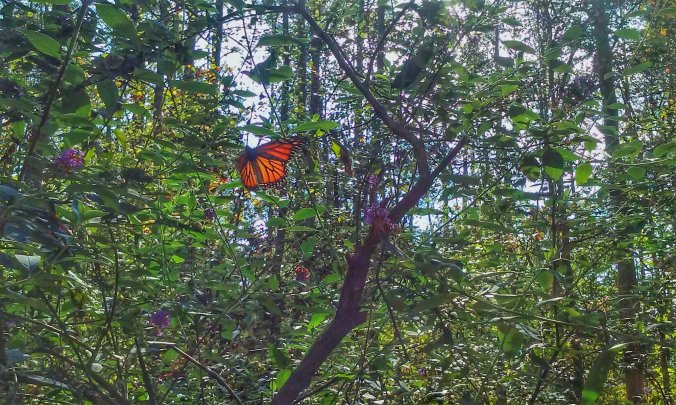
Yesterday I planted more plants and watched two monarchs hanging out in my garden all afternoon. One thing I realized… they had eyes only for my butterfly bush. No interest in any of my other pollinator plants.
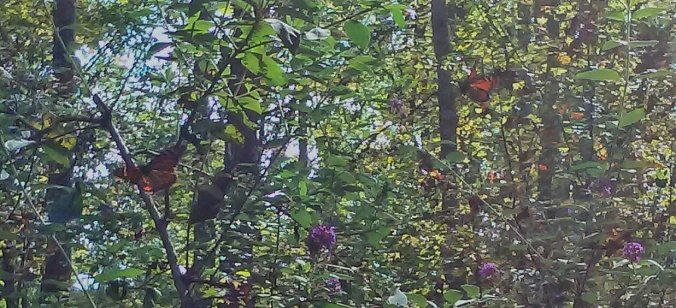
I managed one shot with both in the same photo, but it’s a little hard to see them.
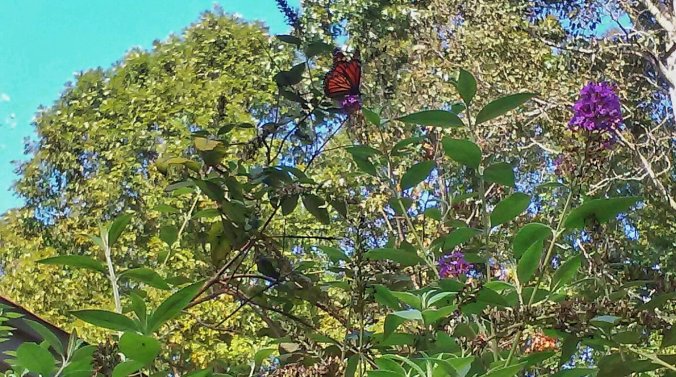
They really are like flying flowers!
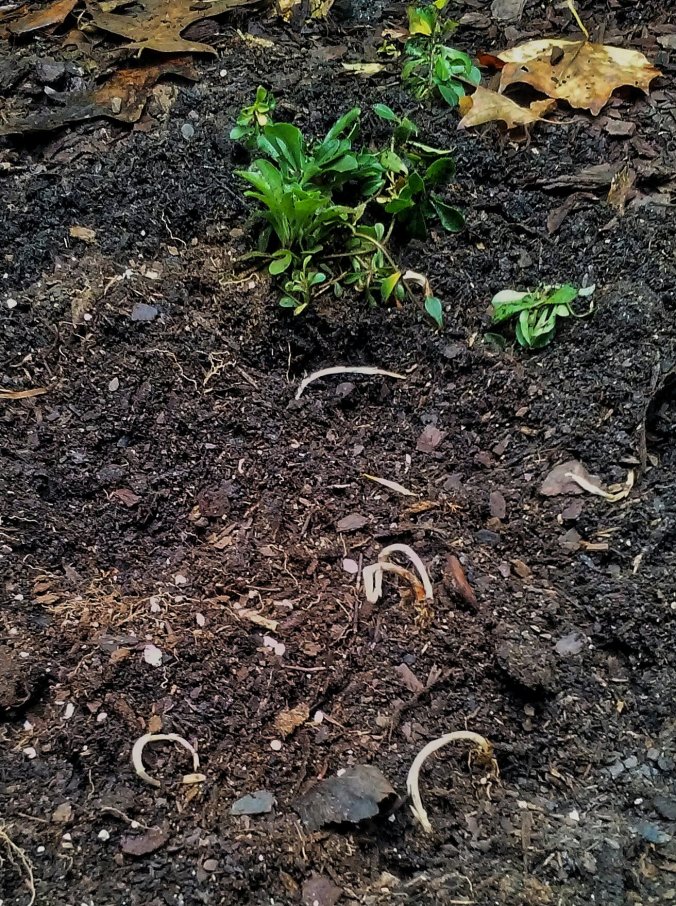
I planted Lily of the Valley (the little white wormy-looking plants) and Creeping Phlox (in background).
Lily of the Valley is not native, but they are so cute! They grow in forests in the Northern Hemisphere in Europe and Asia. In May they produce adorable little white bell-shaped flowers. Later in the season, they produce green berries that ripen to orange or red. All parts of the plant are poisonous, so I’ve got the safely behind the garden fencing where dogs and little humans cannot get to them. These are considered invasive in northern climates, so I will have to keep a close eye on them. I hope I don’t regret planting these.
Creeping Phlox is a native ground cover. In spring it is completely covered in masses of small star shaped white, pink or purple flowers.
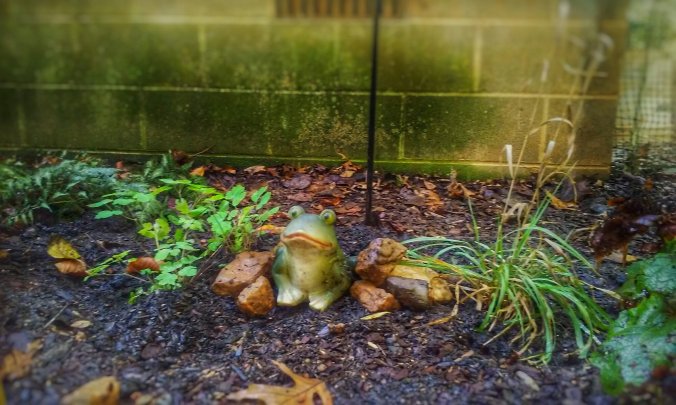
And also Wild Columbine (left side of froggy), Bottlebrush Sedge (right side of froggy), and Virginia Bluebells (not pictured).
Wild Columbine blooms in spring with long red and yellow drooping flowers that attract humminbirds, butterflies, hawk moths and bees. It is a host plant for the Columbine Duskywing moth. Finches and Buntings eat the seeds. Native American men supposedly rubbed crushed seeds on themselves to attract attention from women! Ha!
Bottlebrush Sedge is a native grass that usually grows in marshes and swamps. The seed heads look like little bottle brushes. Sedges are great for wildlife gardens because they are host plants for many insects, and they provide seeds and cover for birds. Many sedges grow quite well in shade compared to grasses.
Virginia Bluebells are native wildflowers that grow in the woods. They start with pretty pastel-pink buds that open up to be long pastel-blue bell-shaped flowers that attract lots of wildlife: hummingbirds, the hummingbird moth, butterflies, and lots of bees.
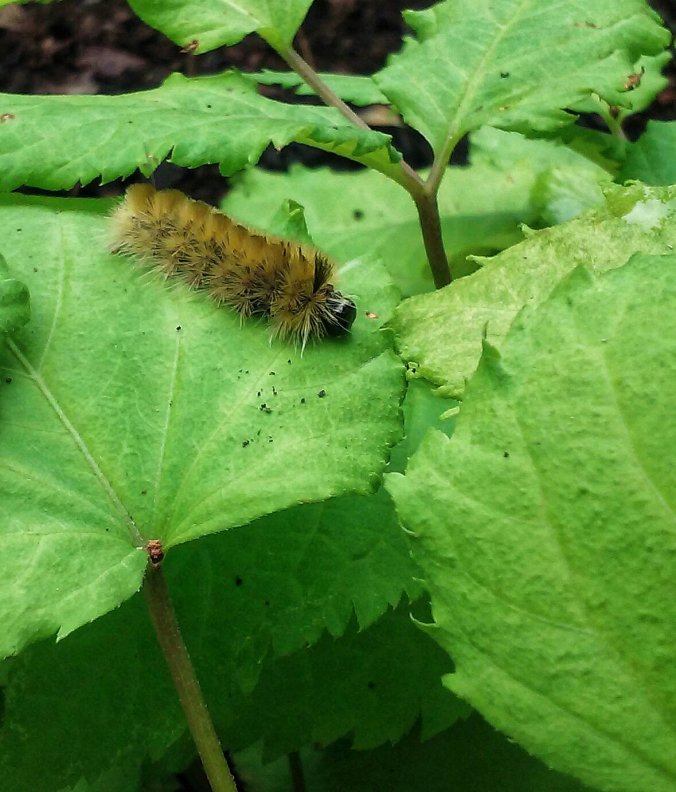
My other wildlife sighting of the day! I researched him, and found out that he is an American Dagger Moth caterpillar (he will turn into a pretty plain-looking gray moth). Their fur is irritating if you touch them. They actually spin their “fur” into their cocoon! The black hairs are fake antennae, that make them appear more threatening than they actually are. They feed on oaks and other trees. They are usually seen in late summer/early fall as they look for a place to spin their cocoon.
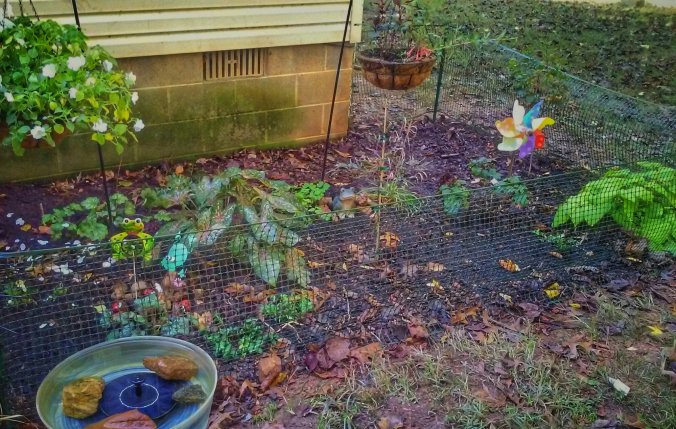
I have now finished planting all the native plants in my part-sun garden and my shade garden (above)! Now on to the full sun garden!
To give you an idea of how I created my garden, I took photos as I planted my fragrant sumac shrub today.

First I dig a hole a lot wider and deeper than the plant.

I put the clay into 5 gallon buckets. The clay from one hole usually fills up six buckets.

I dump the clay out at the edge of the woods. This is one of the clay ridges I’ve created.


I dump top soil and compost into the hole and mix it up.
Then in goes the plant… I water it very well…
And my fragrant sumac is happy in its new home!
Fragrant sumac is not poisonous, like regular sumac. It is a low growing shrub with amazing fall color, which you can already see!

The female plant has fragrant flowers in spring, which provide nectar for butterflies. In fall it produces berries that are food for birds and wildlife. (I sure hope I got a female plant!) and it’s a larval host for the Red-banded hairstreak butterfly.
Each time I finish planting one plant, I take a little break. Today Roman gave me a hug during my break, to tell me he was very proud of me!
Earlier today I planted these natives as well…

Great blue lobelia is the blue counterpart to the red Cardinal flower, so I planted them next to each other. They both attract hummingbirds in late summer and early fall.
Monkey flower’s blooms look like monkey faces. They bloom spring until fall, and are larval host plants for the Baltimore and Common Buckeye butterflies.

Blue star is covered in soft blue star-shaped flowers clustered at the top of the plant for several weeks in spring. In fall the leaves turn yellow. It is a larval host plant for butterflies, and provides nectar to hummingbirds, butterflies, and other pollinators.
Thread leaf coreopsis (aka Tickseed-because the seeds look like ticks) is covered in yellow daisy-like flowers from early spring until fall. The leaves are narrow and fern-like. Birds (especially goldfinches) eat the seeds in winter, if flower heads are left on to dry. I will be leaving all of my flowers out in winter to provide food for birds and wildlife. They make great cut flowers too.

I have always called Woodland sunflowers “Elizabeth’s flowers” because they bloom profusely along the side of our road on her birthday each year. So I had to add it to my garden! The yellow daisy-like flowers on 5′ – 6′ stems attract a wide variety of bugs, pollinators, butterflies and moths. Many birds and other wildlife eat the seeds.

Spikenard is a perennial that will grow up to 6′ tall each year, then it dies back each winter. It has large heart shaped leaves that are covered in cloud-like white or yellow flower-clusters in summer that pollinators love. In fall the leaves turn yellow and it produces red berries that turn purple, which birds devour!

Spicebush is a very important host plant for Spicebush Swallowtail and Eastern Tiger Swallowtail butterflies. In spring it is covered in yellow flowers before it leafs out (some people call it “wild forsythia”). In fall the leaves turn yellow and the branches are covered in bright red drupes (elongated berries) that birds, possums and raccoons eat up.

So… this is what my yard looks like after a day of planting! Not so pretty, huh? Haha!